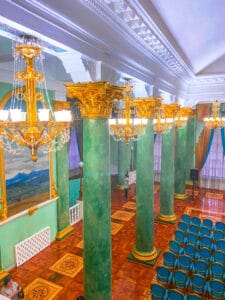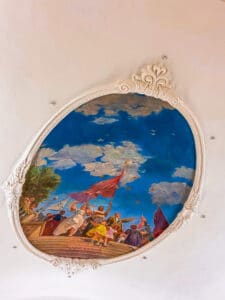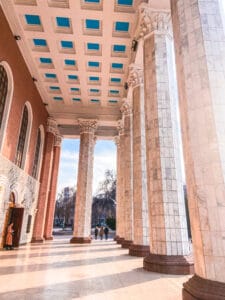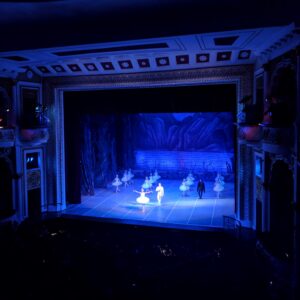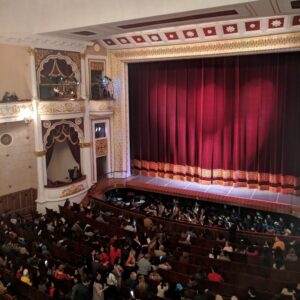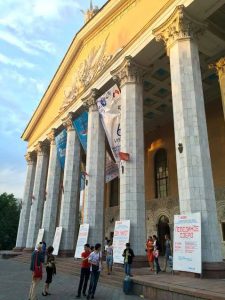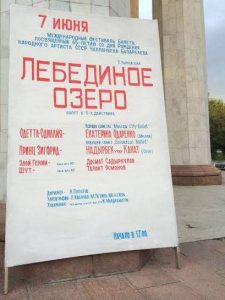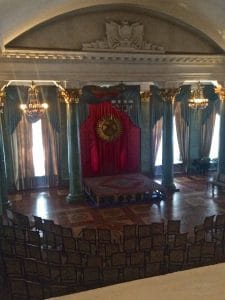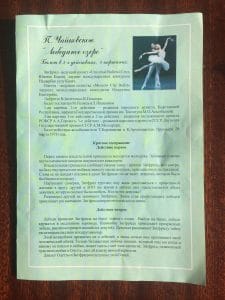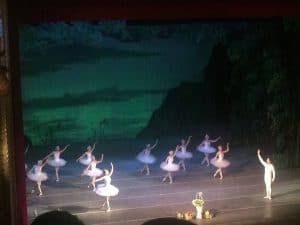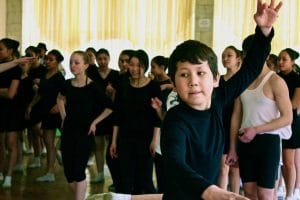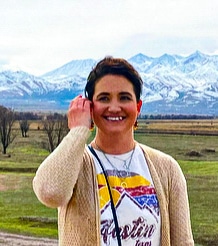The Kyrgyz State Opera and Ballet Theater is a prominant fixture in central Bishkek with a nearly century-old history. It is a pride of the city’s artistic and intellectual community and often recommended to SRAS students studying in Bishkek by locals. Below is the history and performances of this great institution as told by American students who have seen productions at the theater.
History of the Kyrgyz State Opera and Ballet Theater
By Maria Holderbaum
Kyrgyz State Opera and Ballet Theater was founded in Bishkek (formerly known as “Frunze”) on November 7, 1930. It was then Kyrgyzstan’s first and only European-style theatrical institution. Under the Soviet Union, opera houses and ballet theaters were constructed in major cities across all fifteen Soviet Republics.
In 1937, the first Kyrgyz-language musical drama, Altyn Kyz (Golden Girl) was performed at the Kyrgyz State Theater; shortly after, in 1938, a second, Azhal Orduna (Not Death, But Life) premiered. These performances were just the beginning for the Kyrgyz State Theater. In 1939, the first Kyrgyz-language opera, by Abdylas Maldybaev, Vladimir Vlasov and Vladimir Fere, called Ai-Churek was performed in four acts. This successful opera graced the stage and became a centerpiece of Kyrgyz theatrical culture. Ai-Churek is the longest running Kyrgyz musical drama and is still performed today.
In 1939, the “First Decade of Kyrgyz Art and Literature in Moscow” was held, in which Altyn Kyz, Azhal Orduna and Ai-Churek travelled to Moscow for guest performances. On June 7, 1939, the Kyrgyz State Theater was awarded the Order of V.I. Lenin for excellence in the development of theatrical and musical culture, awarded by the decree of the Presidium of the Supreme Soviet of the USSR.
On August 17, 1942, the Kyrgyz State Theater was renamed as the V.I. Lenin Kyrgyz State Opera and Ballet Theater and in 1955 it found its permanent home, which sits on Abdrahmanov St in Bishkek’s city center. The impressive building was built by architect L. Laburenko, with participation from P. Ivanov. Unlike the traditional Soviet style constructs, the style of the theater is reminiscent of classical Greek traditions with grand Greek style columns, bas reliefs that portray the muses and, of course, the Soviet hammer and sickle.
On March 24, 1959, the theater was awarded the title of Academic and in 1978, the theater was officially renamed as the Kyrgyz State Order of V.I. Lenin Academic Opera and Ballet Theater, named after the Kyrgyz Composer, Abdylas Maldybayev.
During its Soviet career, the theater produced hundreds of operas and ballets, such as Swan Lake, Eugene Onegin, La Traviata, Don Carlos, Prince Igor, La Boheme, Faust, and the Queen of Spades – just to name a few. Since the collapse of the Soviet Union, the theater has continued to produce and perform many operas and ballets, with many of the aforementioned productions still running today.
During all this this time, many Russian musicians, composers, artists, and directors came to the Kyrgyz Republic to perform at the Kyrgyz State Theater and help develop it into a local European-style institution. Contributing talents included the famous composer, Vladimir Vlasov, conductor, Vasily Tselikovskiy and director, Vladimir Vasiliev. All of these artists greatly influenced the further development of performance in the Kyrgyz Republic.
Eugene Onegin at The Kyrgyz State Opera and Ballet Theater (2022)
By Maria Holderbaum
I knew one of the things I wanted to do while living in Bishkek was see a Russian opera. I had many options to choose from but I choose Евгений Онегин/Eugene Onegin. I choose this opera because I was familiar with the story, and I knew I would not be able to follow the opera word for word in Russian; having some backstory would give me the opportunity to follow it as closely as possible without getting too lost. The opera is performed in three acts (seven scenes), with one intermission and 10-15 minutes between each act.
Евгений Онегин was composed by Pyotr Llyich Tcaikovsky and the story closely follows passages from Alexander Pushkin’s 1825-1832 novel in verse. The story follows Eugine, a self-centered, selfish man who wins the affection of Татьяна Ларина/Tatyana Larina. Tatyana falls madly in love with Eugine, however, he does not reciprocate his love. Eugene is then invited to a party for Tatyana by his best friend Владимир Ленский/Vladimir Lensky, where he becomes uncomfortable and irritated, and he starts flirting with Tatyana’s sister. Vladimir is unhappy with Eugene and challenges him to a duel. Eugene is unsure of accepting, but he does so to save face and ends up killing his best friend. After this, Eugene leaves the country and does not return for a few years. Upon his return, he attends a ball, where he sees a beautiful woman, who turns out to be Tatyana. Eugene becomes obsessed with winning her over, but he is too late, as she has married. He tries everything to win her over; she admits to still loving him, but she will not allow him to ruin her marriage. Tatyana denies him and leaves him only with regrets. It is a tragic and powerful opera.
Purchasing tickets for the Kyrgyz State Theater should be easy, as you can buy them directly from its website. However, when I tried the site would not accept my credit cards. I also had a friend try her Kyrgyz credit card and to no avail. You can also purchase tickets directly at the box office, inside the theater the night of the show, which is what I did, and I had no issues. I suggest arriving 15 minutes early if you’re going to purchase your tickets at the box office. It seemed most people were doing this, and the queue got quite long.
For this particular opera, ticket prices ranged from 100 som to 450 som/$1.05 USD to $4.75 USD. I opted for the 450 som ticket, as I wanted a seat closer to the stage, however, in this theater you really can’t go wrong with any seat you choose. When you purchase your tickets at the ticket counter, there is a clearly marked seat map where you can choose which seat you would like. The map is also color coded based on the price of the ticket, which helps if you are on a specific budget.
Once inside, you’ll drop your coat off at the coat check, they will give you a plastic token with your coat number and you’ll be surrounded by portraits of famous Kyrgyz and Russian performers, composers, directors, and conductors. Make your way into the theater, where you will be met with comfortable, maroon, felt seats, and a magnificent painted ceiling, with a beautiful chandelier.
During intermission, I suggest walking around the opera house, as there are many rooms to see that are used for weddings, dinners, and exhibits. Luckily, one of the ballrooms was open while I was there; inside was absolutely spectacular! The room was adorned with elegant, green marble columns, multiple chandeliers, beautifully tiled flooring, and another impressive painted ceiling.
If you need to use the restroom between acts, be prepared for a long line; I would suggest bringing tissues or a few pieces of toilet paper with you, as there was no toilet paper in any of the stalls. Carrying tissues is generally a good idea in Bishkek as this is not uncommon. The opera house also has refreshments, such as beer, wine, and light snacks for sale on the lower level, close to the women’s restroom.
The opera itself was fantastic! While the set design was pretty average, as in they used the same table and chairs throughout all acts, and the backdrops had many wrinkles; the costumes were on par with other operas I have been to. The singers were really wonderful, especially Tatyana and Eugine, their voices were powerful, clear and the crowd seemed very pleased. The audience was filled mainly with locals, however there were a few foreigners, other than myself. After each act, the locals hollered and clapped. At the end of the show, each singer came out on stage, where they were met with standing ovations from the audience, loud clapping, and whistles and the three main singers who played Tatyana, Eugene and Vladimir were given a bouquet of flowers. The standing ovation lasted a good three minutes, and only ended when the singers left the stage.
Overall, I would highly suggest seeing an opera while you’re in Bishkek. The opera house is elegant, well organized and a great cultural experience. While this opera may not be as glamourous as others I have been to, the performances were outstanding, and I would definitely go back to see another show.
Swan Lake at the Kyrgyz State Opera and Ballet Theater (2019)
By Camryn Vaughn
Kyrgyz State Opera and Ballet Theater in Bishkek is striking. It looms large on Yusup Abdrahmanov street near Ala-Too Square with large white columns stretching in front of the pink building. Its elegance is alluring. After one of my teachers at the London School showed me the website for buying tickets for productions held there, I found several plays, comedy shows, ballets, and concerts coming up. I had my mind set on ballet and, in particular, the International Ballet Festival called “Ballet, Ballet…” that was taking place between November 14 and November 17. The festival is in honor of Cholponbek Bazarbaev’s 70th birthday. Bazarbaev was a highly talented Kyrgyz dancer and People’s Artist of the USSR.
Four ballet productions were being performed over the course of the festival: Cholpon, Giselle, Swan Lake, and a final gala performance to end the festival. The prices for all four were comparable to one another, with different seat availability. I purchased tickets for Swan Lake about two weeks before the performance. For all four performances, the first eleven rows closest to the stage (called “the parterre” on the website’s seating chart) had already been sold. These tickets were also the most expensive, at 1500-2000 som (21.50-29 USD). Prices for seats in the mezzanine, (labelled amphitheater) were around 1000 som (14.30 USD) and had more availability. Balcony tickets cost 800 som (11.50 USD) and offered great visibility. The website lets you choose your exact seats.
After choosing your seats, you can pay with credit card on the website and electronic tickets will be sent by you via email, along with a receipt. I didn’t have any problems with using the website to complete the purchase. Tickets are available at the theater up until the start of the performance as well.
My friend and I arrived by taxi 10 minutes early. We were glad we weren’t overdressed; a skirt or dress is appropriate for women and a collared shirt or sweater for men. I had my electronic tickets pulled up on my phone, but the ticket taker didn’t even scan the QR codes before waving us through the doors. There was a long line at the coat check we had to fight through, but the service was at least complimentary.
We were quite pleased with our balcony seats. Because they were the cheapest option, there were a lot of little kids sitting around us. One was kicking my seat before the show, but she knocked it off eventually. Theater etiquette was at a minimum (in the balcony, at least). People were coming and going through the doors during the performance, but never enough to really disturb my enjoyment of the performance.
I only received a flyer at the door for another performance of Swan Lake happening later in December. Programs could be purchased separately, but I had difficulty located anyone selling them. I read on the website that the roles of the Prince and the Swan were to be played by visiting ballerinas from the Kremlin Palace in Moscow. The rest of the roles were played by dancers from the local ballet company.
Swan Lake is presented in four acts with a 10-15 minute intermission between each act. There was a signal to let theater goers know when to head back to their seats. We spent the first intermission hunting for champagne, without luck. During the third, we were fruitful and found the snack station located on the right side of the building on the other side of the coat check, near the bathrooms. Juice, soda, and water were available along with wine, beer, and cocktails. Snacks ranged from bags of chips to fancy open-faced sandwiches and desserts. We ordered a cheesecake and glass of red wine for 270 som (3.90 USD) each. It was absolutely delicious, and we felt very classy despite how quickly we had to finish it in order to make it back up to the balcony on time.
The International Ballet Festival in Bishkek (2014)
By Lauren Bisio
When a friend suggested spending an evening at the ballet, I leapt at the opportunity. While ballet may not necessarily spring to mind when thinking about Kyrgyz culture, I thought it would be both an entertaining artistic outing and a chance to experience some remaining effects of Soviet cultural policies.
The Soviets built theaters across the USSR, including in the capitals of the fifteen Union Republics. The Kyrgyz State Opera and Ballet Theater in Bishkek was built in the early 1950s, and at its peak the opera and ballet companies maintained an extensive repertory, with over 200 productions per year. This emphasis on art and culture brought Russian art forms, artists, and productions to the outermost regions of the USSR, while also creating opportunities for national cultural expression. Traditional art forms were reinterpreted and incorporated into European performance platforms: orchestras of traditional instruments, or ballets and operas with national themes and costumes, for example.
Opinions on the merits of these policies are divided. While some praise the Soviet recognition of national cultures and their elevation to the grand stages of state theaters, others point out the continued dominance of Russian productions. Within the diverse cultures of the Union Republics national art forms coexisted alongside Russian forms, but the Russian forms benefitted from state-level support, lending prestige against which national forms couldn’t compete. Regardless of the debate over the effects of these Soviet policies, national cultures were significantly altered by their Russian encounters, hybrid forms were created, and European arts like opera and ballet persist in Central Asia to this day. Unlike Turkmenistan, where ballet and opera were banned as foreign influences by President Niyazov in 2001, ballet remains popular in Kyrgyzstan and ballet schools are full of eager young students.
Thus I found myself one Saturday night at the International Festival Ballet of Kyrgyzstan’s production of Swan Lake. Full disclosure: I am a former professional modern dancer with eighteen years of ballet training under my belt, so my eye may be more critical than the average ballet-goer’s. Was this production the most professional ballet I’ve ever seen? No. The lead male and female roles of Siegfried and Odette/Odile were performed by guest artists from the Universal Ballet in Seoul and the Moscow City Ballet. The use of such guest artists usually indicates that there are no local dancers capable of performing the demanding roles. The corps de ballet dancers were sometimes not in unison, the décor was sparse, and the costumes seemed on the verge of unraveling onstage. There were a few visible mistakes, most notably when the lead ballerina was dropped in the final, dramatic scene.
These observations are shared by others I’ve spoken with, including locals who have told me that the ballet company is criticized for its lack of training and preparation for performances. Technique, scenery, and costumes only carry a production so far, however, and there were many enjoyable aspects to this production of Swan Lake. Early on in the performance I caught two of the male corps de ballet dancers lock eyes and smile, and their joy in performing was palpable among the other dancers throughout the evening. As far as I’m concerned, that enthusiasm among the corps and the generosity of the dancers in their performance is far more laudable than flawless technique.
Beyond the drama playing out onstage, the audience experience was entertaining, too. I entered the beautiful theater among other patrons dressed to the nines; clearly, the ballet is an event here. I saw more than a couple young women in floor-length gowns, and cursed the fact that I hadn’t thought to bring a ball gown to Bishkek. Up in the balcony surrounded by families with young children, however, I fit right in wearing pants and a blouse. Rows and rows of kids were seated up in the balcony, including girls lost in the magic of the ballet and boys lost in their cell phone games. This was my favorite part of the evening. The whispers and candy wrappers and exclamations were a little distracting at times, but the sheer delight radiating from the kids in the audience was heartwarming. The little girl next to me leaned over to ask me a question in the first act, and confessed shyly that she studies ballet. By the third act she and her friends were shouting “Bravo” after each solo, and the applause lasted so long when the curtain finally came down that she complained her hands were hurting from all the clapping. The kids around me certainly didn’t care about a few mistakes or less than perfect technique, and by the end of the performance, neither did I.
I would definitely return to the Kyrgyz State Opera and Ballet Theater for another performance. In fact, I’m looking forward to catching an upcoming performance of Чолпон/Cholpon, which, when it was originally performed in 1944, was the first Kyrgyz ballet.
You Might Also Like
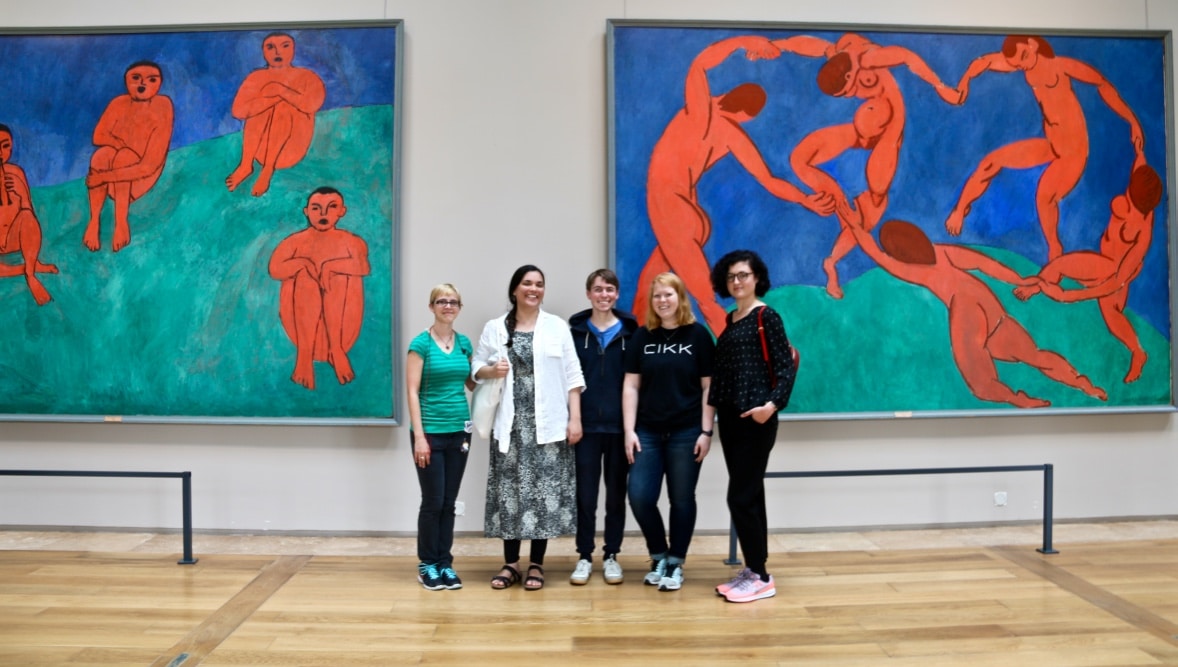
Museums as Self-Care
In 2018, doctors in Montreal began prescribing visits to the Montreal Museum of Fine Arts (MMFA) for patients experiencing depression, anxiety, and other health issues. This innovative approach to mental health treatment was launched under the initiative of the MMFA in collaboration with Médecins francophones du Canada (MFdC). The program allows physicians to provide patients […]
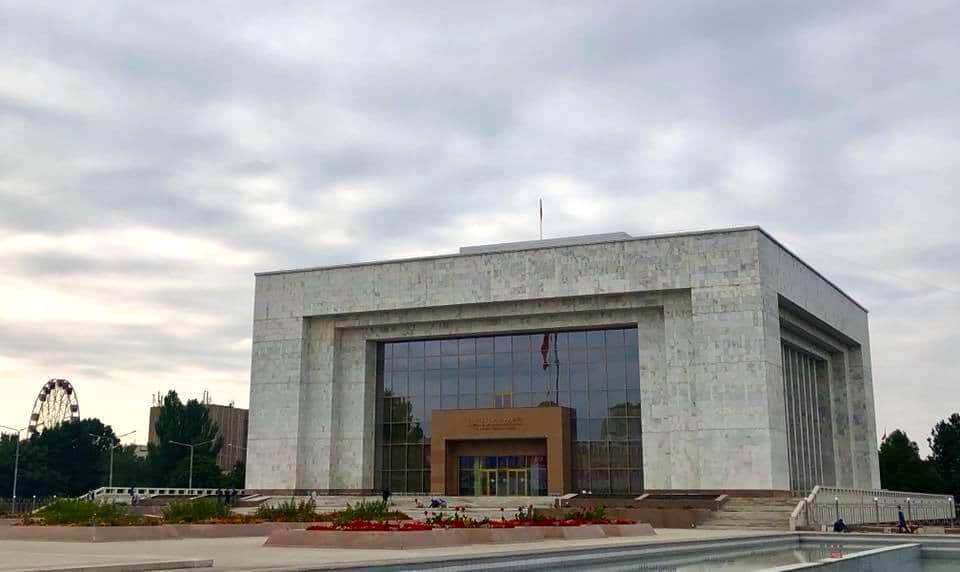
Guide to Bishkek’s Top Museums for Students
The Kyrgyz were largely a nomadic civilization up until the 20th century. The city of Bishkek has a number of museums documenting this fascinating history as well as the development of the arts and sciences in Kyrgyzstan. These museums were mostly established during (and today are often unchanged from) Soviet times, including a number of […]
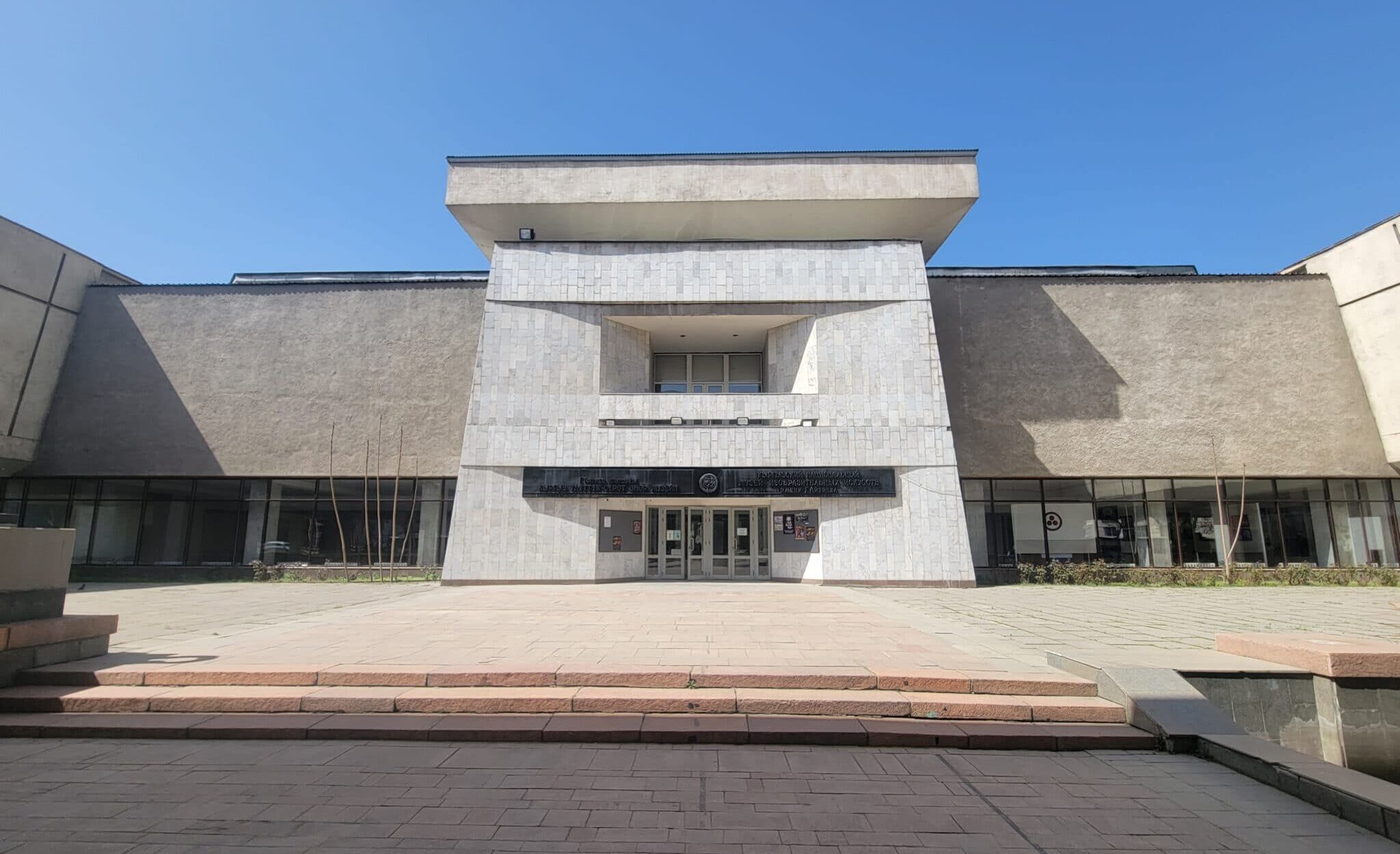
The Kyrgyz National Museum of Fine Arts in Bishkek
The Kyrgyz National Museum of Fine Arts in Bishkek showcases native art forms as well as painting, sculpture, and other works, highlighting those created by Kyrgyz artists. The museum is centrally located and is perfect for a day trip with an abundance of restaurants and cafes nearby. The article below will tell the history of […]
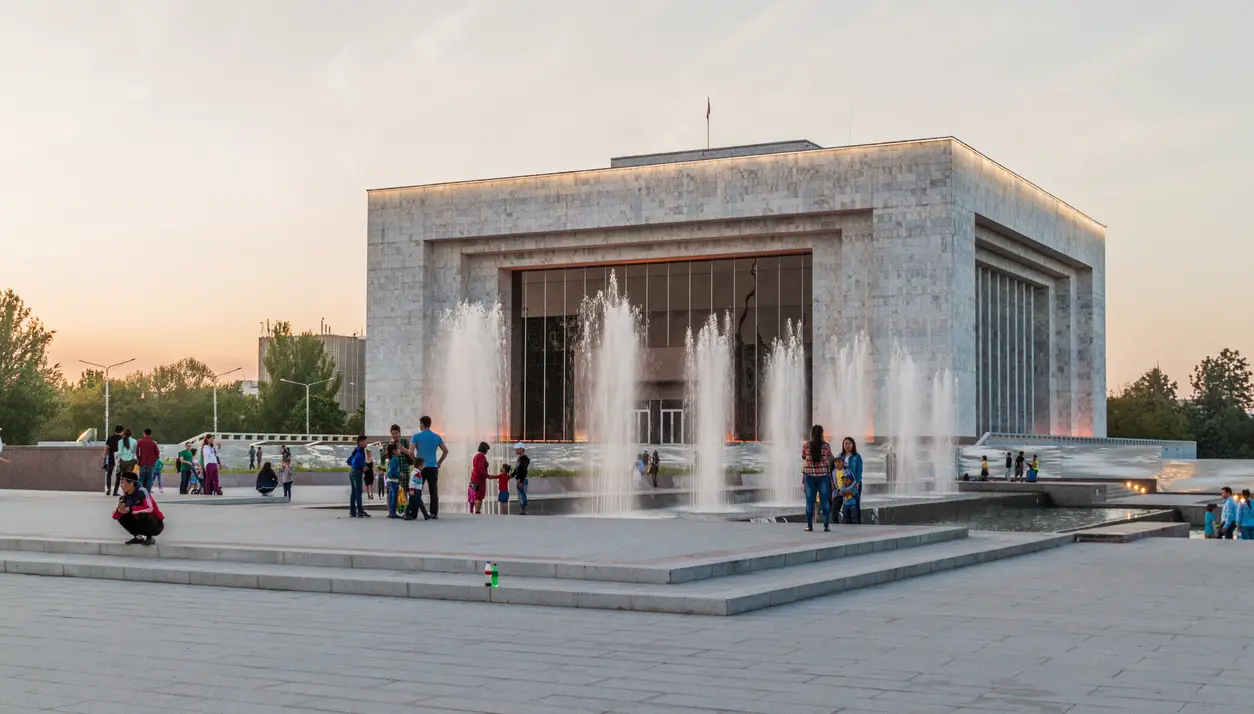
The National Historical Museum of the Kyrgyz Republic
The National Historical Museum of the Kyrgyz Republic is a great place to get started when visiting Kyrgyzstan. The museum’s extensive collection of more than 90,000 exhibits includes artifacts from Kyrgyzstan’s prehistory, from its ancient Silk Road era, Soviet-era history, and modern state. Culture exhibits focus on Kyrgyz nomadic culture, traditional handicrafts, and the musical […]

The Evolution of Art and Painting in Central Asia
While Central Asia has a long, rich history, the modern nations of the region are a direct result of 20th century colonization. Prior to Soviet interference, the many ethnic groups and distinct societies of the region were loosely grouped under the geographic term of Turkestan. Under Soviet control, the region was divided into the Turkmen […]



